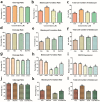Crosstalk between Peroxisomal Activities and Nrf2 Signaling in Porcine Embryos
- PMID: 34068072
- PMCID: PMC8152488
- DOI: 10.3390/antiox10050771
Crosstalk between Peroxisomal Activities and Nrf2 Signaling in Porcine Embryos
Abstract
Melatonin and phytanic acid (PA) are known to be involved in lipid metabolism and β-oxidation, in which peroxisomal activities also significantly participate. In addition, other studies have reported that the nuclear factor-erythroid-derived 2-like 2 (Nrf2 or NFE2L2) signaling pathway mediates lipid metabolism and its subsequent cascades. As these mechanisms are partially involved in porcine oocytes or embryonic development, we hypothesized that the factors governing these mechanisms could be interconnected. Therefore, we aimed to investigate possible crosstalk between peroxisomal activities and Nrf2 signaling in porcine embryos following melatonin and PA treatment. Porcine embryos were cultured for seven days after parthenogenetic activation, and subsequently treated with melatonin and PA, or injected with Pex19-targeted siRNAs. Real-time PCR, immunocytochemistry, and BODIPY staining were used to evaluate peroxisomal activities, Nrf2 signaling, and subsequent lipid metabolism. We found that melatonin/PA treatment enhanced embryonic development, whereas injection with Pex19-targeted siRNAs had the opposite effect. Moreover, melatonin/PA treatment upregulated peroxisomal activities, Nrf2 signaling, lipid metabolism, and mitochondrial membrane potentials, whereas most of these mechanisms were downregulated by Pex19-targeted siRNAs. Therefore, we suggest that there is a connection between the action of melatonin and PA and the Nrf2 signaling pathway and peroxisomal activities, which positively influences porcine embryonic development.
Keywords: IVC; Nrf2 signaling; lipid metabolism; melatonin; phytanic acid; porcine embryos.
Conflict of interest statement
The authors declare that there is no conflict of interest.
Figures








Similar articles
-
Phytanic acid-derived peroxisomal lipid metabolism in porcine oocytes.Theriogenology. 2020 Nov;157:276-285. doi: 10.1016/j.theriogenology.2020.07.007. Epub 2020 Jul 12. Theriogenology. 2020. PMID: 32823023
-
Melatonin-Nrf2 Signaling Activates Peroxisomal Activities in Porcine Cumulus Cell-Oocyte Complexes.Antioxidants (Basel). 2020 Nov 3;9(11):1080. doi: 10.3390/antiox9111080. Antioxidants (Basel). 2020. PMID: 33153240 Free PMC article.
-
Melatonin enhances porcine embryo development via the Nrf2/ARE signaling pathway.J Mol Endocrinol. 2019 Oct;63(3):175-185. doi: 10.1530/JME-19-0093. J Mol Endocrinol. 2019. PMID: 31408847
-
Regulatory crosstalk between the oxidative stress-related transcription factor Nfe2l2/Nrf2 and mitochondria.Toxicol Appl Pharmacol. 2018 Nov 15;359:24-33. doi: 10.1016/j.taap.2018.09.014. Epub 2018 Sep 18. Toxicol Appl Pharmacol. 2018. PMID: 30236989 Review.
-
Involvement of NRF2 in Breast Cancer and Possible Therapeutical Role of Polyphenols and Melatonin.Molecules. 2021 Mar 25;26(7):1853. doi: 10.3390/molecules26071853. Molecules. 2021. PMID: 33805996 Free PMC article. Review.
Cited by
-
Porcine Follicular Fluid-Derived Exosome: The Pivotal Material for Porcine Oocyte Maturation in Lipid Antioxidant Activity.Int J Mol Sci. 2023 Jun 6;24(12):9807. doi: 10.3390/ijms24129807. Int J Mol Sci. 2023. PMID: 37372955 Free PMC article.
-
Cannabis sativa (Hemp) seed-derived peptides WVYY and PSLPA modulate the Nrf2 signaling pathway in human keratinocytes.PLoS One. 2024 May 23;19(5):e0298487. doi: 10.1371/journal.pone.0298487. eCollection 2024. PLoS One. 2024. PMID: 38781174 Free PMC article.
-
Melatonin and Related Compounds: Antioxidant and Anti-Inflammatory Actions.Antioxidants (Basel). 2022 Mar 10;11(3):532. doi: 10.3390/antiox11030532. Antioxidants (Basel). 2022. PMID: 35326182 Free PMC article.
References
Grants and funding
LinkOut - more resources
Full Text Sources
Research Materials

